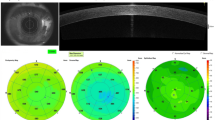Abstract
Epithelial permeability and autofluorescence of the cornea were determined by fluorophotometry in 21 patients with open-angle glaucoma or ocular hypertension using timolol medication with the preservative benzalkonium chloride (BAC) and 2 weeks after changing to timolol medication without BAC. The investigation was performed to determine whether removal of BAC would reduce toxic effects on the cornea and complaints of sensations of burning or dry eye. Corneal epithelial permeability decreased significantly after changing medication (mean decrease per patient 27%, P=0.025). Corneal autofluorescence increased significantly after changing medication suggesting an alteration in corneal metabolism (mean increase per patient 6%, P = 0.003). Timolol without BAC was found to be as effective as timolol with BAC in reducing intraocular pressure (P=0.4). Removal of BAC from timolol resulted in an improvement of corneal epithelial barrier function and in a reduction of complaints. The improvement was found to be proportional to the duration of the preceding BAC-containing therapy.
Similar content being viewed by others
References
Burstein NL (1984) Preservative alteration of corneal permeability in humans and rabbits. Invest Ophthalmol Vis Sci 25:1453–1457
Chance B, Lieberman M (1978) Intrinsic fluorescence emission from the cornea at low temperatures: evidence of mitochondrial signals and their differing redox status in epithelial and endothelial sides. Exp Eye Res 26:111–117
Coakes RL, Brubaker RF (1978) The mechanism of timolol in lowering intraocular pressure in the normal eye. Arch Ophthalmol 96:2045–2048
De Kruijf EJFM, Boot JP, Laterveer L, Best JA van, Ramselaar JAM, Oosterhuis JA (1987) A simple method for determination of corneal epithelial permeability in humans. Curr Eye Res 6:1327–1334
Fraunfelder FT (1989) Drugs used primarily in ophthalmology Meyer SM (ed) Drug-induced ocular side effects and drug interactions. Lea & Febiger, Philadelphia, p 476–477
Kaufmann HE (1980) Timolol maleate. Ophthalmology 87:164–168
Kuppens EVMJ, Best JA van, Stolwijk TR, Keizer RJW de (1994) Topical timolol, corneal epithelial permeability and autofluorescence in glaucoma by fluorophotometry. Graefe's Arch Clin Exp Ophthalmol 232:215–220
Masters BR (1984) Noninvasive redox fluorometry: how light can be used to monitor alterations of corneal mitochondrial function. Curr Eye Res 3:23–26
Ramselaar JAM, Boot JP, Haeringen NJ van, Best JA van, Oosterhuis JA (1988) Corneal epithelial permeability after instillation of ophthalmic solutions containing local anaesthetics and preservatives. Curr Eye Res 7:947–950
Stolwijk TR, Best JA van, Boot JP, Oosterhuis JA (1990) Corneal autofluorescence in diabetic and penetrating keratoplasty patients as measured by fluorophotometry. Exp Eye Res 51:403–409
Stolwijk TR, Best JA van, Oosterhuis JA, Swart W (1992) Corneal autofluorescence: an indicator of diabetic retinopathy. Invest Ophthalmol Vis Sci 33:92–97
Zimmerman TJ, Harbin R, Pett M, Kaufmann HE (1977) Timolol and facility of outflow. Invest Ophthalmol Vis Sci 16:623–624
Zimmerman TJ, Baumann JD, Hetherington Jr J (1983) Side effects of timolol. Surv Ophthalmol 28:243–249
Author information
Authors and Affiliations
Rights and permissions
About this article
Cite this article
de Jong, C., Stolwijk, T., Kuppens, E. et al. Topical timolol with and without benzalkonium chloride: epithelial permeability and autofluorescence of the cornea in glaucoma. Graefe's Arch Clin Exp Ophthalmol 232, 221–224 (1994). https://doi.org/10.1007/BF00184009
Received:
Revised:
Accepted:
Issue Date:
DOI: https://doi.org/10.1007/BF00184009



